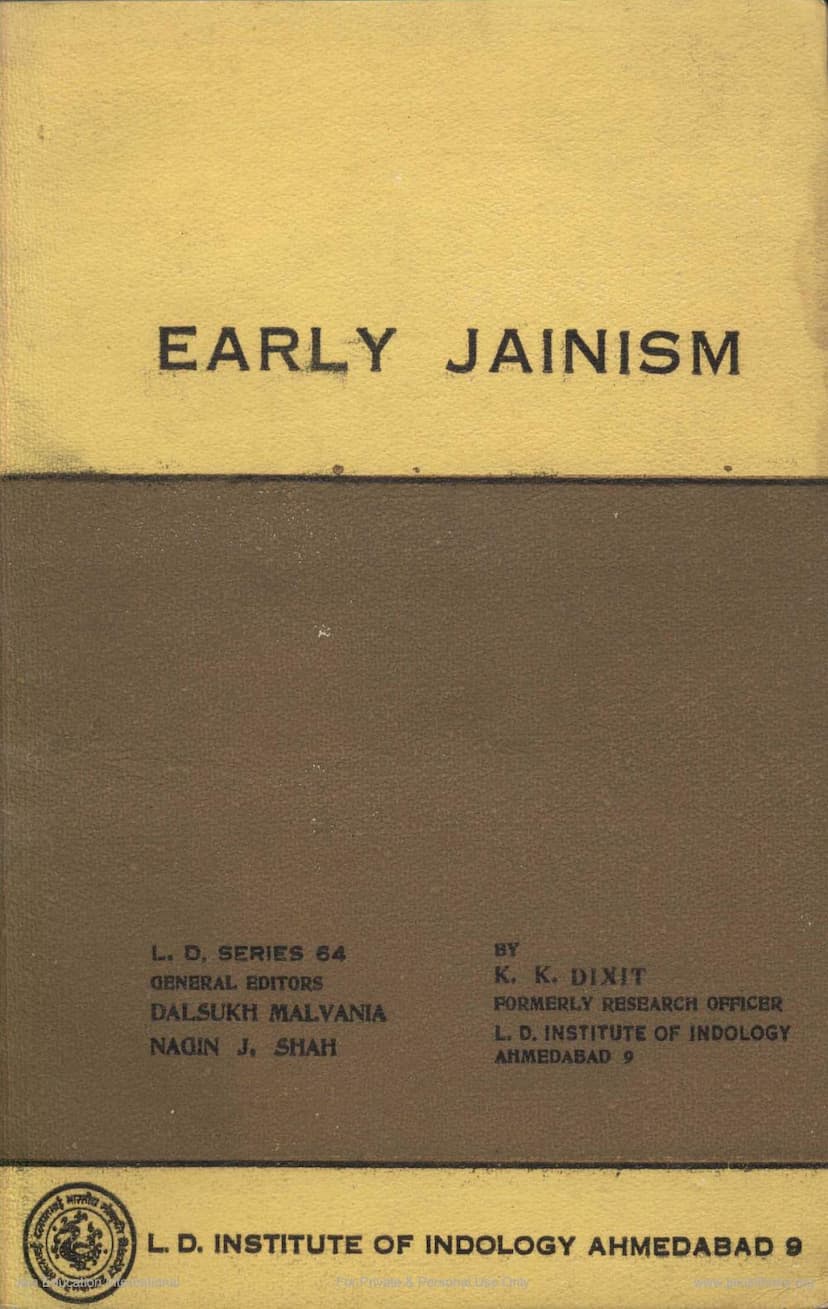Early Jainism
Added to library: September 1, 2025

Summary
Here's a comprehensive summary of "Early Jainism" by K. K. Dixit, based on the provided text:
Book Title: Early Jainism Author: K. K. Dixit Publisher: L. D. Institute of Indology, Ahmedabad Publication Date: January 1978
Core Argument and Purpose: The book, "Early Jainism" by K. K. Dixit, aims to present a historically and critically evaluated picture of the earliest phase of Jainism. Dixit meticulously analyzes the contents, language, and meter of early Jaina canonical texts (Āgamas) to distinguish them from later interpolations and developments. He argues that understanding these early texts is crucial for a correct historical perspective on Jainism and for critically assessing later reform movements within it.
Key Themes and Findings:
-
Distinguishing Early vs. Late Jainism: Dixit emphasizes the necessity of differentiating between the early and later phases of any religion, including Jainism. He contends that early Jainism, as reflected in texts like Ācārānga I and Sūtrakṛtānga I, was characterized by relative simplicity in ideology and observances, while later phases became more complex.
-
Analysis of Early Canonical Texts: The book focuses on a critical historical evaluation of several key early Jaina texts, including:
- Ācārānga I and Sūtrakṛtānga I: These are considered the oldest, characterized by their predominantly verse composition (using old Vedic meters like Triṣṭubh and Anuṣṭubh), emphasis on renunciation, extreme asceticism, and the condemnation of arambha (violence) and parigraha (possessions) as the worst sins. They also reveal a primitive form of the karma doctrine and a lack of specialized ontology, epistemology, mythology, or a "super-humanized" biography of Mahavira.
- Uttarādhyayana and Daśavaikālika: These texts are dated as the next oldest after Ācārānga I and Sūtrakṛtānga I. They continue the emphasis on monastic life and asceticism, with Uttarādhyayana showcasing a shift towards more varied literary forms and Daśavaikālika highlighting the emerging significance of the five mahāvratas (great vows) and a more systematic approach to monastic ethics. Both show signs of developing concepts and a more complex social outlook than the earliest texts.
- The Four Old Chedasūtras (Daśā, Kalpa, Vyavahāra, Niśitha): These texts deal extensively with monastic discipline. Dixit notes their prescriptive nature and the evolving organizational structure of the Jaina monastic community, moving from solitary wandering to organized ganas and gacchas. Niśitha is identified as covering a wider range of problems, often with specific punishments outlined.
- Ācārānga II: This text is considered relatively late due to its prose composition, systematic treatment of monastic discipline, and engagement with concepts like śruta, mati, and darśana.
- Five Anga Texts (Story Collections): Texts like Jñātadharmakathā, Upāsakadaśā, Antakṛddaśā, Anuttaraupapātikadaśā, and Vipākaśruta are analyzed for their historical significance, particularly their role in edifying the laity and illustrating core Jaina doctrines through stories. Dixit notes the prevalence of stereotyped narratives and the gradual evolution of concepts like rebirth in heavenly regions for ideal monks and pious householders.
- Praśnavyākaraṇa: This text is considered late due to its ornate prose style, reminiscent of contemporary prose authors. It details vices and virtues, emphasizing the consequences of actions in this life and the next.
- Ṛṣibhāṣita: A collection of didactic verses attributed to various sages, many of whom may not be Jaina or are fictitious. Its rarity of Jaina technical terminology suggests either non-Jaina authorship or an early period before the full development of Jaina terminology. The text is seen as preserving the foundational ascetic principles common to Indian thought.
- Suttanipāta (for Jaina Studies): Dixit highlights the relevance of certain passages in the Buddhist Suttanipāta for understanding early Jainism, as they illuminate shared ancestral concepts that later Jainism emphasized more, such as asrava, samvara, nirjara, and the concept of parīṣaha.
-
Noteworthy Features of Early Jainism (Ācārānga I & Sūtrakṛtānga I):
- Unconditional World-Renunciation: A strong condemnation of the householder's life and an absolute emphasis on embracing monkhood.
- Extremely Hard Ascetic Life: Monks were expected to endure severe hardships to minimize dependence on society.
- Arambha and Parigraha as Worst Sins: Violence and attachment to possessions were considered the most fundamental sins, with parigraha being the proximate cause and arambha the immediate cause of sinful activity.
- Sixfold Objects of Arambha: The Jainas identified six types of living beings (earth, water, fire, air, plants, and mobile beings), implying that violence towards any of these was sinful.
- Absence of Technical Terminology: Early texts were largely devoid of later Jaina technical terms like kaṣāya (passions) and mahāvratas (great vows), though the concepts behind them were present. Similarly, pariṣaha (hardships) and bhikṣādoṣa (defects of alms) were discussed but not yet standardized into technical categories.
- Primitive Karma Doctrine: The texts mention karma, rebirth, and liberation but are silent on the precise mechanisms, unlike later Jaina speculation.
- No Special Ontology, Epistemology, or Mythology: Early Jainism did not articulate unique ontological or epistemological theories; its mythology was also not significantly elaborated.
- Non-Super-Humanized Biography of Mahavira: While Mahavira's asceticism is described, his biography lacks the later mythological embellishments.
-
Evolution of Concepts: The book traces the development of Jaina concepts, such as:
- The refinement of the karma doctrine.
- The emergence and standardization of the mahāvratas and kaṣāyas.
- The systematization of monastic rules and the structure of monastic communities.
- The development of sophisticated literary styles, particularly in the story-texts.
- The distinction and classification of cognition (darśana, mati, śruta).
-
Critique of Later Interpretations: Dixit implicitly or explicitly critiques the interpretations of later commentators and reform movements (like Sthānākavāsism) by highlighting how they sometimes misinterpret or misattribute texts to support their views.
Conclusion: "Early Jainism" by K. K. Dixit is a scholarly work that uses philological and historical methods to reconstruct the foundational period of Jainism. It underscores the radical nature of early Jain asceticism and renunciation, contrasting it with the more developed and complex doctrines and practices of later periods. The book serves as an essential resource for understanding the historical trajectory of Jaina thought and practice.